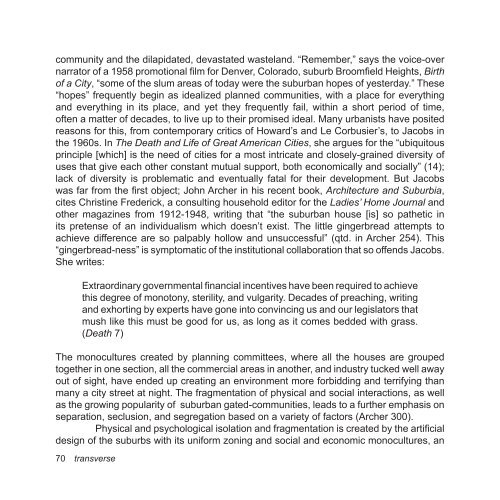Untitled - Centre for Comparative Literature - University of Toronto
Untitled - Centre for Comparative Literature - University of Toronto
Untitled - Centre for Comparative Literature - University of Toronto
You also want an ePaper? Increase the reach of your titles
YUMPU automatically turns print PDFs into web optimized ePapers that Google loves.
community and the dilapidated, devastated wasteland. “Remember,” says the voice-over<br />
narrator <strong>of</strong> a 1958 promotional fi lm <strong>for</strong> Denver, Colorado, suburb Broomfi eld Heights, Birth<br />
<strong>of</strong> a City, “some <strong>of</strong> the slum areas <strong>of</strong> today were the suburban hopes <strong>of</strong> yesterday.” These<br />
“hopes” frequently begin as idealized planned communities, with a place <strong>for</strong> everything<br />
and everything in its place, and yet they frequently fail, within a short period <strong>of</strong> time,<br />
<strong>of</strong>ten a matter <strong>of</strong> decades, to live up to their promised ideal. Many urbanists have posited<br />
reasons <strong>for</strong> this, from contemporary critics <strong>of</strong> Howard’s and Le Corbusier’s, to Jacobs in<br />
the 1960s. In The Death and Life <strong>of</strong> Great American Cities, she argues <strong>for</strong> the “ubiquitous<br />
principle [which] is the need <strong>of</strong> cities <strong>for</strong> a most intricate and closely-grained diversity <strong>of</strong><br />
uses that give each other constant mutual support, both economically and socially” (14);<br />
lack <strong>of</strong> diversity is problematic and eventually fatal <strong>for</strong> their development. But Jacobs<br />
was far from the fi rst object; John Archer in his recent book, Architecture and Suburbia,<br />
cites Christine Frederick, a consulting household editor <strong>for</strong> the Ladies’ Home Journal and<br />
other magazines from 1912-1948, writing that “the suburban house [is] so pathetic in<br />
its pretense <strong>of</strong> an individualism which doesn’t exist. The little gingerbread attempts to<br />
achieve difference are so palpably hollow and unsuccessful” (qtd. in Archer 254). This<br />
“gingerbread-ness” is symptomatic <strong>of</strong> the institutional collaboration that so <strong>of</strong>fends Jacobs.<br />
She writes:<br />
Extraordinary governmental fi nancial incentives have been required to achieve<br />
this degree <strong>of</strong> monotony, sterility, and vulgarity. Decades <strong>of</strong> preaching, writing<br />
and exhorting by experts have gone into convincing us and our legislators that<br />
mush like this must be good <strong>for</strong> us, as long as it comes bedded with grass.<br />
(Death 7)<br />
The monocultures created by planning committees, where all the houses are grouped<br />
together in one section, all the commercial areas in another, and industry tucked well away<br />
out <strong>of</strong> sight, have ended up creating an environment more <strong>for</strong>bidding and terrifying than<br />
many a city street at night. The fragmentation <strong>of</strong> physical and social interactions, as well<br />
as the growing popularity <strong>of</strong> suburban gated-communities, leads to a further emphasis on<br />
separation, seclusion, and segregation based on a variety <strong>of</strong> factors (Archer 300).<br />
Physical and psychological isolation and fragmentation is created by the artifi cial<br />
design <strong>of</strong> the suburbs with its uni<strong>for</strong>m zoning and social and economic monocultures, an<br />
70 transverse




